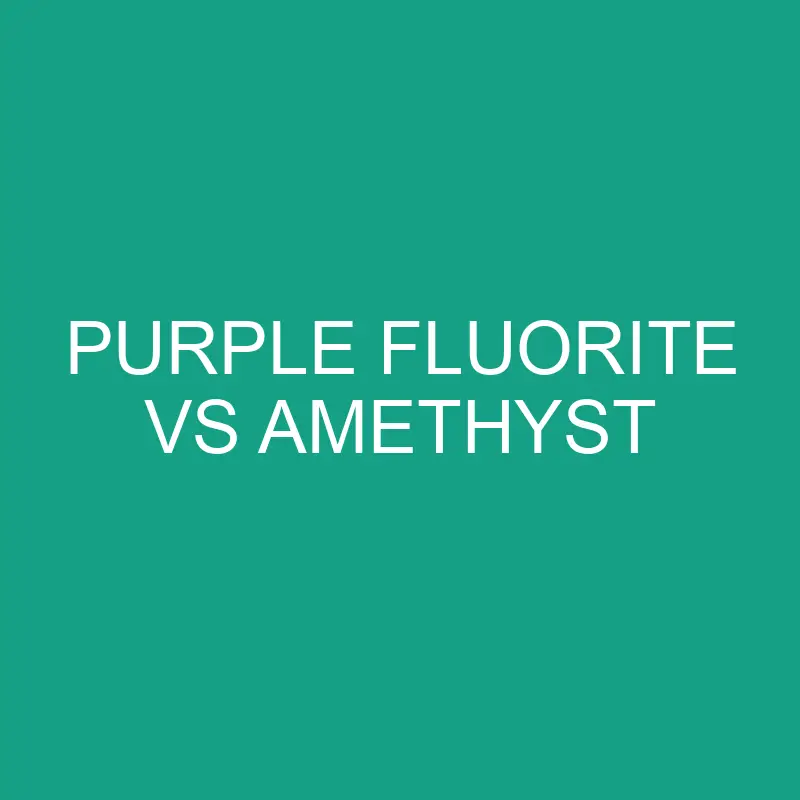A Radiant Duel of Violet Gemstones
In the kaleidoscope of gemstones, purple holds a unique fascination, captivating admirers with its regal charm and spiritual allure. Among the array of violet-hued gems, Purple Fluorite and Amethyst stand out, each boasting distinct characteristics and a rich history of symbolism. In this exploration, we will unravel the mystical qualities and aesthetic beauty of Purple Fluorite and Amethyst, delving into their geological origins, physical properties, metaphysical significance, and their unique roles in the world of jewelry and spirituality.
Post Contents
Purple Fluorite: The Lustrous Beauty of Fluorescent Violet
Origins and Geological Background:
- Composition: Purple Fluorite is a calcium fluoride mineral belonging to the halide group. Its purple color comes from the presence of impurities and exposure to natural radiation.
- Formation: Fluorite forms in hydrothermal veins and is often associated with minerals like quartz and calcite.
Physical Properties:
- Color and Appearance: Purple Fluorite exhibits a range of purple hues, from pale lavender to deep violet. It is known for its glassy luster and cubic crystal habit.
- Transparency: The transparency of Purple Fluorite can vary from transparent to translucent.
- Crystal Structure: Fluorite crystallizes in the cubic system, forming distinct octahedral or cubic crystals.
- Hardness: On the Mohs scale, Fluorite has a hardness of 4.
Origins and Mining:
- Locations: Purple Fluorite is found in various locations globally, including China, Mexico, Argentina, and the United States.
- Mining: Extracted through mining operations, Fluorite is collected for its ornamental and metaphysical uses.
Metaphysical Properties:
- Spiritual Clarity: Fluorite is often associated with mental clarity and focus. Purple Fluorite, in particular, is believed to enhance spiritual awareness and intuition.
- Chakra Association: It is commonly linked to the third eye chakra, aiding in meditation and intuitive insights.
- Balancing Energy: Purple Fluorite is thought to have a stabilizing and balancing energy, promoting emotional well-being.
Uses in Jewelry and Art:
- Jewelry: While not as commonly used in jewelry as some other gemstones, Purple Fluorite can be fashioned into beads, cabochons, and pendants for unique and vibrant pieces.
- Decorative Items: Purple Fluorite is often used in carvings, sculptures, and decorative items, showcasing its beautiful crystal formations.
Amethyst: The Crown Jewel of the Quartz Family
Origins and Geological Background:
- Composition: Amethyst is a variety of quartz, with its purple color attributed to the presence of iron impurities.
- Formation: Amethyst crystals form in cavities within volcanic rocks. The depth of purple can be influenced by factors such as the presence of other minerals and natural irradiation.
Physical Properties:
- Color and Appearance: Amethyst ranges from pale lilac to deep purple, often displaying red and blue flashes known as “play of color.”
- Transparency: It is typically transparent to translucent.
- Crystal Structure: Like other quartz varieties, Amethyst has a hexagonal crystal structure.
- Hardness: On the Mohs scale, Amethyst has a hardness of 7.
Origins and Mining:
- Locations: Amethyst is found in various locations globally, with notable deposits in Brazil, Uruguay, Zambia, and Russia.
- Mining: Extracted through mining operations, Amethyst is one of the most sought-after varieties of quartz.
Metaphysical Properties:
- Spiritual Awakening: Amethyst is widely regarded as a stone of spiritual awakening and enlightenment. It is believed to enhance intuition and psychic abilities.
- Calming Energy: It is associated with calming and balancing energies, promoting inner peace and emotional stability.
- Chakra Association: Amethyst is commonly linked to both the third eye and crown chakras, facilitating a connection to higher spiritual realms.
Uses in Jewelry and Art:
- Jewelry: Amethyst is a popular choice for various jewelry pieces, including rings, necklaces, and earrings. Its deep purple color and association with royalty make it highly prized.
- Carvings and Sculptures: Due to its beauty and size, Amethyst is often carved into intricate sculptures, figurines, and decorative items.
- Historical Significance: Amethyst has been used historically in royal jewelry, symbolizing regality and spiritual power.
Comparative Analysis: Purple Fluorite vs. Amethyst
1. Color Range:
- Purple Fluorite: Exhibits a range of purple hues, from pale lavender to deep violet.
- Amethyst: Ranges from pale lilac to deep purple, often with red and blue flashes.
2. Transparency:
- Purple Fluorite: Can vary from transparent to translucent.
- Amethyst: Typically transparent to translucent.
3. Crystal Structure:
- Purple Fluorite: Forms in the cubic system, displaying octahedral or cubic crystals.
- Amethyst: Has a hexagonal crystal structure, characteristic of the quartz family.
4. Chakra Association:
- Purple Fluorite: Linked to the third eye chakra, aiding in spiritual awareness and intuition.
- Amethyst: Associated with both the third eye and crown chakras, facilitating a connection to higher spiritual realms.
5. Hardness:
- Purple Fluorite: Has a hardness of 4 on the Mohs scale.
- Amethyst: Has a hardness of 7 on the Mohs scale.
6. Locations:
- Purple Fluorite: Found in various locations globally, including China, Mexico, Argentina, and the United States.
- Amethyst: Found globally, with significant deposits in Brazil, Uruguay, Zambia, and Russia.
7. Uses in Jewelry:
- Purple Fluorite: Less commonly used in jewelry but can be fashioned into beads, cabochons, and pendants.
- Amethyst: Highly prized and widely used in various jewelry pieces, from rings to necklaces.
8. Metaphysical Properties:
- Purple Fluorite: Associated with mental clarity, spiritual awareness, and balancing energy.
- Amethyst: Considered a stone of spiritual awakening, with calming and balancing properties.
9. Decorative Items:
- Purple Fluorite: Often used in carvings, sculptures, and decorative items, showcasing its crystal formations.
- Amethyst: Carved into intricate sculptures and decorative pieces, historically used in royal jewelry.
Conclusion: Embracing the Majesty of Purple
In the ethereal realm of purple gemstones, both Purple Fluorite and Amethyst invite individuals to immerse themselves in the mystical and regal world of violet hues. While Purple Fluorite captivates with its unique cubic crystal formations and balancing energies, Amethyst reigns as the crown jewel of the quartz family, symbolizing spiritual awakening and inner peace.
